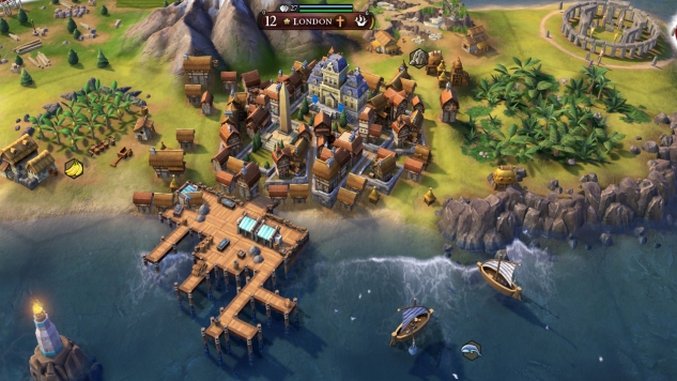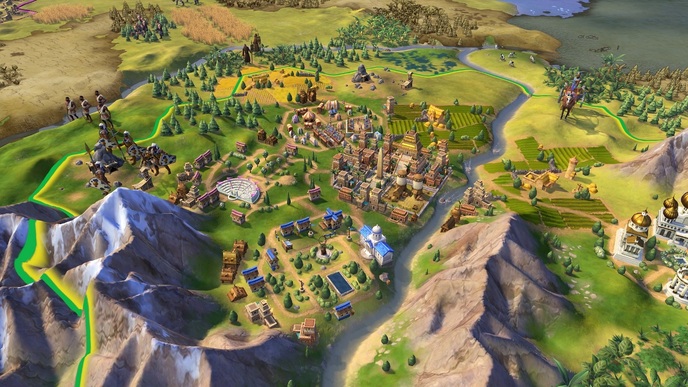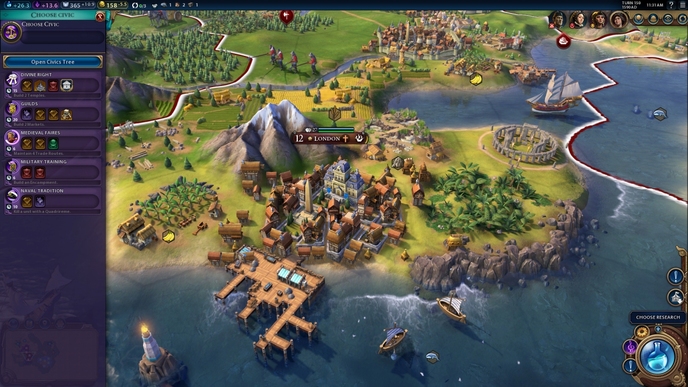Courtesy of AC2:
Firaxis Didn't Plan It, But Civilization VI is Shaping Up to Be a Great Educational Tool
Paste Magazine
By Leif Johnson | August 3, 2016 | 1:00pm

If you haven’t heard, someone’s reworking Sid Meier’s Civilization V as a teaching tool for schools. The great wonder is that it took so long. Even a decade ago, when I was just one more factoid about 17th century Dutch economics away from being overwhelmed by my graduate studies in history, I found the series’ abstract take on the rise of nations a welcome beacon of intuitive simplicity. For millions of others, it’s proven that the “maps and chaps” approach to history doesn’t have to be a snooze. This educational focus was very much on my mind as I headed to New York last week to play the most recent build of the upcoming Civilization VI (due out in October), and I’d convinced myself that developer Firaxis was working more educational elements into its core game than it had before.
If they are, it’s apparently inadvertent. When I spoke to Sarah Darney, the associate producer for Civilization VI, she seemed surprised by the topic and quickly reminded me that GlassLab, a third-party company, is responsible for the translation. But neither is she averse to the idea that players might be learning some new things while charting a course for world domination as they scrounge for resources and upgrade their civilization’s technologies as they have for five other games.
“The whole franchise lends itself to teaching people while they have fun,” Darney said, drawing particular attention to the in-game “Civilopedia” that details the real-world histories behind the landmarks and personalities encountered in the game. “There’s so much rich history that you can learn.”
But it’s not really the rote memorization of dates and names that I have in mind. Oregon Trail, after all, didn’t beat its players over the head with staid facts about particular mountain passes and trailblazers, but most of its players nevertheless walked away with a good idea of the hardships faced along the way to the West Coast. When their oxen died, they learned the importance of conserving resources.

The Civ series is a little like that, and Civilization VI particularly so. The newest game allows players to build their cities’ districts over multiples tiles on the gridded map rather than a single one as in Civ V, and figuring out which districts to place by which imparts some basic knowledge of city planning through gameplay alone. Knowledge of how to interact with the surrounding world thus becomes more important. Cities thrive near fresh water sources; away from them, they wither. The sprawl of cities encourages the use of natural barriers like mountains to keep invaders away from prized districts. In a masterful stroke, the preview event itself subtly hammered home these lessons. Held in an atrium overlooking Central Park and Broadway, a mere look out the window encouraged contemplation of how Gotham’s residential and commercial districts interacted with each other.
Civ VI, in many ways, is a Civ for our time. Ours is an age when important news from other countries drops more frequently than rolled newspapers on porches in ages past, and thus never before has it been so important for students to grasp the logic behind international cooperation and struggle. A good chunk of the game remains much the same as it always has, but it’s the remaining 33 percent (in Darney’s words) that already seems to make it more effective as a learning tool than its predecessor. Here, for instance, is a greater focus on a “Civics” tree as a condition to victory, which ultimately leads to less material concepts that we’re all familiar with in the modern age (and which I’m not allowed to talk about right now).
And then there are the leaders. Civ has a reputation for playing fast and loose with history at times, most notably in the case of Gandhi, whose in-game incarnation tends to relish the thought of nuking uncooperative neighbors. Civ VI maintains some of that volatility with hidden agendas for its civilization leaders that change from match to match, but it also gives those leaders permanent agendas that more closely align with those of their real-life counterparts. Consider Theodore Roosevelt, whose famous “Big Stick” policy comes to life in his tendency to leave neighbors alone as long as they leave him alone, but bully them if they start trouble. Or take the ancient Chinese emperor Qin Shi Huang, who grows jealous of any civilization who dare to build wonders more glorious than his own.
“We really wanted to find big characters, people that had personalities that stand out,” Darney said, “but also lent themselves to a certain type of gameplay.”
It’s even fun to watch them, particularly when figures like France’s Catherine de’ Medici, the United Kingdom’s Queen Victoria, or Egypt’s Cleopatra show up in the diplomacy interactions and chitchat with vividly colored, stylized models and lively animations. It’s an approach that’s especially effective for teaching players about leaders like Brazil’s Pedro II “the magnanimous,” who doesn’t enjoy the same level of fame as some of the other available civilization leaders like Montezuma.

“I was never that kid in school who opened up my history textbook and got excited about learning all the dates,” said Darney. “Once you put a story to it and you create something this interesting and interactive, I think you retain the information better. It’s fun.”
Yet that liveliness of style has also been a point of contention in the community. Compared to Civilization V, Civilization VI has a more “cartoony” look, which prompted some negative comparisons to free-to-play mobile games like Clash of Clans when the first screenshots appeared. But its strengths become more obvious in motion. There’s a timeless beauty to the style, and the animations for the little skirmishes that unfold across the maps have never been more fun to watch. According to Brian Busatti, the art director for Civilization VI, the art style actually grew out of that drive for richer detail.
“We wanted to create a style where you can see from farther zoomed out,” Busatti said. “You can still tell what the districts are. You can still tell what your units are. You can see a lot of the action going on, like the animations are a little bit bolder than they’ve been in the past, and it just allows combat to be cooler and faster.”

I could also see how such an art style might work well in schools, but Busatti denies there was any drive to appeal to a younger audience. Busatti also denies that the style will allow Civ VI to run on weaker PCs than Civilization V—the kind you might find, say, in a typical public school—as the inclusion of better combat animations and sprawling cities actually roughly evens things out.
It’s almost as if Firaxis created a great educational game for schools in spite of themselves. It’s so effective, in fact, that I find it a shame that Firaxis didn’t ask GlassLab to wait until this release and model its classroom version on it. Civilization V, released in 2010, is undeniably a great game, but the additions in Civilization VI help it communicate the elements of strategy and the motives that drive leaders more adeptly than previous releases, all while somehow remaining fun. That, I believe, is a balance that’s too often missing from today’s entertainment.
Perhaps civilization would be better off if we heed its lesson well.
Paste Magazine
By Leif Johnson | August 3, 2016 | 1:00pm

If you haven’t heard, someone’s reworking Sid Meier’s Civilization V as a teaching tool for schools. The great wonder is that it took so long. Even a decade ago, when I was just one more factoid about 17th century Dutch economics away from being overwhelmed by my graduate studies in history, I found the series’ abstract take on the rise of nations a welcome beacon of intuitive simplicity. For millions of others, it’s proven that the “maps and chaps” approach to history doesn’t have to be a snooze. This educational focus was very much on my mind as I headed to New York last week to play the most recent build of the upcoming Civilization VI (due out in October), and I’d convinced myself that developer Firaxis was working more educational elements into its core game than it had before.
If they are, it’s apparently inadvertent. When I spoke to Sarah Darney, the associate producer for Civilization VI, she seemed surprised by the topic and quickly reminded me that GlassLab, a third-party company, is responsible for the translation. But neither is she averse to the idea that players might be learning some new things while charting a course for world domination as they scrounge for resources and upgrade their civilization’s technologies as they have for five other games.
“The whole franchise lends itself to teaching people while they have fun,” Darney said, drawing particular attention to the in-game “Civilopedia” that details the real-world histories behind the landmarks and personalities encountered in the game. “There’s so much rich history that you can learn.”
But it’s not really the rote memorization of dates and names that I have in mind. Oregon Trail, after all, didn’t beat its players over the head with staid facts about particular mountain passes and trailblazers, but most of its players nevertheless walked away with a good idea of the hardships faced along the way to the West Coast. When their oxen died, they learned the importance of conserving resources.

The Civ series is a little like that, and Civilization VI particularly so. The newest game allows players to build their cities’ districts over multiples tiles on the gridded map rather than a single one as in Civ V, and figuring out which districts to place by which imparts some basic knowledge of city planning through gameplay alone. Knowledge of how to interact with the surrounding world thus becomes more important. Cities thrive near fresh water sources; away from them, they wither. The sprawl of cities encourages the use of natural barriers like mountains to keep invaders away from prized districts. In a masterful stroke, the preview event itself subtly hammered home these lessons. Held in an atrium overlooking Central Park and Broadway, a mere look out the window encouraged contemplation of how Gotham’s residential and commercial districts interacted with each other.
Civ VI, in many ways, is a Civ for our time. Ours is an age when important news from other countries drops more frequently than rolled newspapers on porches in ages past, and thus never before has it been so important for students to grasp the logic behind international cooperation and struggle. A good chunk of the game remains much the same as it always has, but it’s the remaining 33 percent (in Darney’s words) that already seems to make it more effective as a learning tool than its predecessor. Here, for instance, is a greater focus on a “Civics” tree as a condition to victory, which ultimately leads to less material concepts that we’re all familiar with in the modern age (and which I’m not allowed to talk about right now).
And then there are the leaders. Civ has a reputation for playing fast and loose with history at times, most notably in the case of Gandhi, whose in-game incarnation tends to relish the thought of nuking uncooperative neighbors. Civ VI maintains some of that volatility with hidden agendas for its civilization leaders that change from match to match, but it also gives those leaders permanent agendas that more closely align with those of their real-life counterparts. Consider Theodore Roosevelt, whose famous “Big Stick” policy comes to life in his tendency to leave neighbors alone as long as they leave him alone, but bully them if they start trouble. Or take the ancient Chinese emperor Qin Shi Huang, who grows jealous of any civilization who dare to build wonders more glorious than his own.
“We really wanted to find big characters, people that had personalities that stand out,” Darney said, “but also lent themselves to a certain type of gameplay.”
It’s even fun to watch them, particularly when figures like France’s Catherine de’ Medici, the United Kingdom’s Queen Victoria, or Egypt’s Cleopatra show up in the diplomacy interactions and chitchat with vividly colored, stylized models and lively animations. It’s an approach that’s especially effective for teaching players about leaders like Brazil’s Pedro II “the magnanimous,” who doesn’t enjoy the same level of fame as some of the other available civilization leaders like Montezuma.

“I was never that kid in school who opened up my history textbook and got excited about learning all the dates,” said Darney. “Once you put a story to it and you create something this interesting and interactive, I think you retain the information better. It’s fun.”
Yet that liveliness of style has also been a point of contention in the community. Compared to Civilization V, Civilization VI has a more “cartoony” look, which prompted some negative comparisons to free-to-play mobile games like Clash of Clans when the first screenshots appeared. But its strengths become more obvious in motion. There’s a timeless beauty to the style, and the animations for the little skirmishes that unfold across the maps have never been more fun to watch. According to Brian Busatti, the art director for Civilization VI, the art style actually grew out of that drive for richer detail.
“We wanted to create a style where you can see from farther zoomed out,” Busatti said. “You can still tell what the districts are. You can still tell what your units are. You can see a lot of the action going on, like the animations are a little bit bolder than they’ve been in the past, and it just allows combat to be cooler and faster.”

I could also see how such an art style might work well in schools, but Busatti denies there was any drive to appeal to a younger audience. Busatti also denies that the style will allow Civ VI to run on weaker PCs than Civilization V—the kind you might find, say, in a typical public school—as the inclusion of better combat animations and sprawling cities actually roughly evens things out.
It’s almost as if Firaxis created a great educational game for schools in spite of themselves. It’s so effective, in fact, that I find it a shame that Firaxis didn’t ask GlassLab to wait until this release and model its classroom version on it. Civilization V, released in 2010, is undeniably a great game, but the additions in Civilization VI help it communicate the elements of strategy and the motives that drive leaders more adeptly than previous releases, all while somehow remaining fun. That, I believe, is a balance that’s too often missing from today’s entertainment.
Perhaps civilization would be better off if we heed its lesson well.
